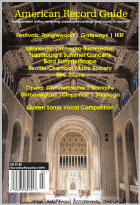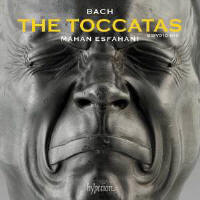Texte paru dans: / Appeared in: Hyperion |
|
|
Outil de traduction ~ (Très approximatif) |
|
|
Reviewer: Rob
Haskins When a pianist or harpsichordist performs one of the Toccatas, he is probably aware that these are early works—at the very least, he would know that it is very much unlike works like the WTC or the Partitas. So then, the vexing question: how should one play Bach’s early harpsi-chord music? In the many releases of the Toccatas I have reviewed, performers— especially pianists—seem to treat them as early, immature works—more diverting oddities unlike the great works that Bach would later compose. Evan Shinners falls into this lamentable category (J/A 2013). Even with harpsichordists who are aware of the stylus phantasticus style of 17th Century music on which Bach probably modeled the pieces, the results are, more or less, a superficial, surface-oriented approach to the toccatas’ untamed excesses. Two exceptions among others: Anthony Newman on Vox (S/O 1996) and Peter Watchorn (N/D 2000).
Mahan Esfahani offers a wide-ranging, historically informed answer to this question that I find extremely attractive and convincing. After a thorough investigation of the numerous sources for these works he makes an extraordinary, but to my mind commonsensical, claim: there is in fact no “authentic” way of performing the works; rather, they
seem to invite, perhaps more
than s me of his other works, what he calls a “dialogic” relationship
between performer and text, one that elevates the former to something much
like a co-creator.
Another important context for
these pieces emerges more clearly in the playing itself rather than from the
essay: the great organ fantasies and toccatas with which Bach would dazzle
audiences for decades. He does this in part with his choice of instrument by
Jukka Ollikka of Prague; it follows theories and surviving examples of
Michael Mietke’s instruments, including what Esfahani calls “the
hypothetical addition of an extra soundboard for the 16’ register and a
cheek inspired by Pleyel, 1912. The instrument is over 9 feet long, had a
wide range, and includes registers of 16’, two 8’, and 4’ with buff on the
upper manual. Finally, the soundboard is made from a carbon-fiber. With this
instrument, Esfahani easily captures the grand sonorities of the organo
pleno if not all of its most colorful solo stops. The two 8’ courses are
very colorful and tender, quite powerful when coupled, the 4’ brilliant but
unobtrusive, and the 16’ (which is used often) extremely robust.
| |
|
|
|
|
Cliquez l'un ou l'autre
bouton pour découvrir bien d'autres critiques de CD |
|




